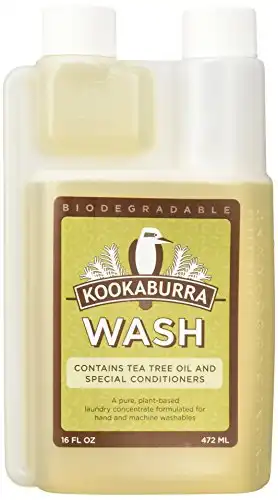- You are here:
- Home »
- Organic Bedding »
- How to Wash a Wool Duvet?
How to Wash a Wool Duvet?
Disclaimer: As an Amazon Associate I earn from qualifying purchases.
Congratulations on your new wool comforter! Wool is one of the most durable fabrics, and it’s naturally resistant to dirt, dust, and bacteria. It doesn’t need to be washed often. In fact, you don’t need to wash a new wool comforter until at least two months after purchase.
But if it’s been a while and your comforter needs a good clean, there are some tips you can follow to make sure that you don’t damage the fabric in the process.
Make Sure Your Wool Comforter Can Be Washed
Natural wool tends not to be washable and you´ll have to dry clean it in order to maintain it in a good shape. But some varieties of wool are specially processed so that they are much more suited for machine washing. If your comforter includes the words “washable” or “pre-washed” on the label, then you’re in luck!
These kinds of wool have been specifically treated and tested so that they can be safely washed without any damage or shrinkage. So before you break out the detergent, make sure to check the tag on your comforter, as anything not labeled “washable” should be professionally dry cleaned only. With a bit of careful checking, you can keep your home looking great with little worry about damaging your favorite wool comforter.
Steps to Wash A Wool Duvet in a Washing Machine
If you have a wool duvet that needs cleaning, then you’ll want to make sure you do it right. Damage to the duvet due to incorrect washing can not only make it lose its thermo-regulating properties but also leave your duvet looking less than its best:
- To avoid any mistakes, start by inspecting your wool for any rips or tears; if there are any, sew them immediately.
- Next, spot-clean any areas with stains with a gentle solution before you toss it into the machine.
- When you’re ready to go, select the wool cycle or gentle cycle on your washing machine and add some detergent formulated for wool products. Set the temperature to cold. Avoid using harsh chemicals or bleach as these may discolor or damage the wool fabric.
- Once finished, don’t opt for the dryer; instead, line-dry your comforter, as this helps keep its shape for longer. That’s all there is to cleaning your wool duvet!
Just by taking these simple steps, you can keep your duvet feeling cozy and smelling fresh without worrying about damaging it.
Can I Handwash a Wool Duvet?
For those of us who are looking for a more hands-on approach to caring for wool bedding, you may want to wash your wool duvet by hand. All you need is a bathtub, bucket, detergent and water:
- Fill up the bucket or bathtub with lukewarm or cold water and add some mild detergent.
- Once you’ve mixed it up well, allow your duvet to soak in the swab solution for around 30-40 minutes before rinsing off with fresh water.
- Be sure to rinse the item several times so that all the soap is removed and none remains when doing this method of cleaning.
- Next, gently press the duvet to remove excess water.
- Finally, it’s always best to let it dry outside instead of using harsh heat when drying.
With a little effort, your wool duvets will look beautiful like new in no time! And don’t forget: cleaning your wool items by hand helps maintain their lifespan and doubles as an upper body workout! Win-win!
Read More: What Are the Pros and Cons of Wool Comforters?
What Are The Best Detergents for Wool Duvets?
It’s best to choose a natural, eco-friendly detergent that is free from any harsh or damaging chemicals. Wool-friendly detergents should also be scent-free and formulated specifically for wool items. And look out for laundry detergents with low sudsing properties, as this will help keep the fibers in your wool duvet soft and fluffy for longer.
We recommend Kookaburra Wool Wash for cleaning wool items. You can also look out for brands like Woolite, which specializes in gentle yet effective cleaning solutions designed to protect wool products.
Read More: Best Organic Wool Pillows
FAQs
How often should you wash your wool duvet?
As a general rule of thumb, we recommend washing your wool duvets every two to three months, as this helps keep them fresh and free from dirt and dust mites. Check the manufacturer´s instructions for the best care recommendations for your particular type of wool duvet.
Is there anything else I need to consider when washing my wool duvet?
Yes – always be gentle when handling and laundering your wool duvet, as the fibers are naturally delicate and prone to damage from rough handling or incorrect washing. Always use a low spin cycle when machine-washing, and ensure you’re using the right detergent for wools.
And never tumble dry your wool duvet – instead, opt for air-drying, which will help prevent it from shrinking or changing shape. Finally, store your wool duvet in a cool, dry area away from direct sunlight and moisture.
Read More: How to Wash a Wool Blanket?
How can I protect my wool duvet from wear and tear?
To keep your wool duvet looking its best, opt for a washable cover; this will help protect the fabric from any spills or dirt build-up while also helping to maintain its shape and texture.
Additionally, try using a lint roller every now and then to pick up any dust particles which may have settled on the surface of your comforter. And finally, be sure to rotate your duvet regularly – this helps prevent any areas of high use from becoming strained over time.
Do I need to use special detergent when washing my wool duvet?
A. Yes! Always opt for a mild detergent specifically designed for wool, like Woolite. This will help keep your duvets looking fresh and fluffy while also protecting the fabric from damage due to harsh chemicals.
And remember to always do a patch test on a small area of the duvet before laundering, just in case!
How to clean a wool comforter that is not washable?
For wool comforters that can’t be washed, we recommend spot-cleaning with a mild soap and warm water solution. Mix together a few drops of the detergent with a cup of lukewarm water in a bowl, stirring gently to combine.
Then using a soft cloth (or old toothbrush), dab at any stains or areas of dirt on your comforter until they come away. Once you’ve finished cleaning, hang the item up outside to let it line dry naturally – never tumble dry!
And if possible, try flipping over your comforter every now and then; this helps keep all sides aired out evenly, which is important for maintaining the fabric’s shape and texture.
You can also vacuum your wool comforter with an upholstery attachment to remove any dust particles and keep it looking fresh. Be sure to use the lowest suction level and keep the nozzle moving to avoid damaging the fibers. And when you’re finished, hang up your comforter outside in a shaded area to let it air out before using it.
You can also dry clean your comforter if you don’t want to do it yourself or if it´s not washable. Be sure to take your item to a qualified professional who specializes in wool and uses a delicate cleaning method. This will help ensure that your comforter comes out looking and feeling as good as new!

Conclusion
In conclusion, wool comforters need special care when laundering and storing them if you want them to stay looking their best for longer. Always opt for a mild laundry detergent specifically designed for wool, and never tumble dry your comforters – instead, rely on gentle hand-washing or air-drying techniques.
Additionally, try spot-cleaning any dirt or dust build-up areas with a soft cloth soaked in warm water with a few drops of mild soap or shampoo. Finally, make sure to keep your wool comforter stored in a cool, dry area away from direct sunlight and moisture, and check it regularly for any signs of wear or tear.
With these simple tips in mind, you can keep your duvet looking and feeling like new for many years to come!
Read More: Wool vs Down Duvet Inserts
About the Author Kamila Flieger
My name is Kamila, and I'm passionate about researching non-toxic, organic products for the home. I believe it's so important to create a safe and healthy environment for our families, and I enjoy helping others do the same.



